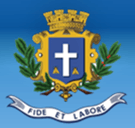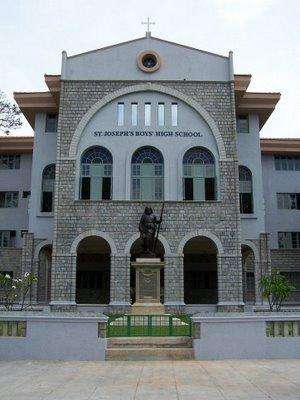St. Joseph's Boys' High School, Bangalore
| St. Joseph's Boys' High School | |
|---|---|
 Faith And Toil | |
| Address | |
|
PO Box 25003 #27, Museum Road Bangalore, Karnataka India | |
| Information | |
| Type | private, Jesuit (Catholic) |
| Established | 1858 |
| Principal | Fr. Clifford Sequeira, S.J. |
| Gender | coed since 2007 |
| Enrollment | 2,000 |
| Number of students |
LKG - 10th (ICSE) 12th grade (ISC) |
| Campus size | 2.7 acres (11,000 m2) |
| Houses |
St.Andrews, St.Davids, St.Georges, St.Patricks. |
| Colour(s) | blue and white |
| Publication | Josephite |
| Affiliation | Indian Certificate of Secondary Education Examination (ICSE) and The Indian School Certificate examination (ISC) |
| Information | +91 80 2221 4416 |
| Website | sjbhsbangalore |
 | |
St. Joseph's Boys' High School (formerly St. Joseph's European High School) located on Museum Road in Bangalore, Karnataka, India, is under Jesuit administration. The school moved to a new building in 2007 in time for its 150th jubilee in 2008. Annually Old Boys Day draws alumni from around the globe. The school's history is detailed by alumnus Christopher Rego in the book "Faith and Toil".[1]
History
St. Joseph's Boys High School, Bangalore, (formerly St. Joseph's European High School) was founded by the Jesuit Fathers and Brothers in 1858 to offer a liberal education for the boys of European and Anglo-Indian families. After India's independence, admission was extended in the 1950s and 1960s to include all students, irrespective of race, religion, or caste. The school buildings are situated in the center of the (formerly European quarter of the) city. Originally the upper floors provided dormitory space.
Large, open playgrounds accommodate sports such as cricket, football, and hockey. and other games and forms of exercise. The cricket team trains at the Centenary Ground located on Mahatma Gandhi Road near the Mayo Hall. The school pays great attention to physical training and sports and has long conducted the Annual Hockey Tournament for ICSE schools in Bangalore. St. Joe's also hosts a Cadet Platoon, a Boy Scout Troop, and Debating and Literary Societies for the higher classes.
In 1883, when J.M. Vissac was rector, the school was situated on St. John's Hill at the current location of St. Germain High School, adjoining St. Francis Xavier's Cathedral. Fr. Vissac relocated the school to a large campus in the heart of the City Cantonment. He purchased the "Rocklands" property adjacent to the Madras Bank (the present State Bank of India) and the Good Shepherd Convent, and designed the buildings on Museum Road in 1894. In 1898, 100 boarders and 89 day scholars moved to the new facility.
By 1913 the school had grown to 239 boarders and 183 day scholars, and two new blocks were added along with an immense playground called "New Fields" on Vittal Mallya Road. The tract had to be drained for the playing fields. In 1910, the school adopted the High School Examination System giving up the Old Matriculation System, and is believed to have at this time adopted the name St. Joseph's European High School. The University meanwhile had abolished the F.A. and replaced it with the Intermediate Arts Exam.
Fr. Vissac had two French priests from the diocese, Frs. Froger and Schmitt, earn their MA from the University of London, England, and they returned to teach. After 20 years Fr. Vissac handed over the reins to Fr. Froger, Rector from 1903 to 1913, and again from 1915 to 1916. Fr. Froger also did the oil paintings on the walls of the priests' and boarders' refectories.
In the first half of the 20th century, the school curriculum was directed toward the Government High and Middle School Examinations, the Cambridge School Certificate, and the Junior and Preliminary Examinations. The School was recognised by Cambridge University and senior candidates could obtain Certificate A of the General Certificate of Education (GCE). The boys prepared for Preliminary Cambridge in Std. VI, for the Middle School in Std. VII, for Junior Cambridge in Std. VIII, and for the High School and Cambridge School Certificate in Std. IX.
During British rule, teachers in Anglo Indian schools had subsidized salaries that were significantly higher than at the Indian SSLC schools. With Independence in 1947, the school lost many of its earlier privileges. Continually rising exam fees of the University of Cambridge, a result of post-war inflation, coincided with a severe foreign currency crunch in India. The Government of India, unwilling to release foreign exchange for these examinations, switched to the Indian School Certificate Council, with two examinations at the end of Classes X and XII, the ICSE (Indian Certificate of Secondary Education) and the ISC (Indian School Certificate). This was done by the Anglo Indian Association under the leadership of Mr. Frank Anthony, its President and Member of Parliament. Also, weekly tests gave way to unit and quarterly tests.
The school follows the ICSE syllabus up to Class X. In 2005 the school expanded its curriculum at both ends. It added Classes I through IV and extended the high school to include the ISC at Class XII. The year 2007 included another first: Class XI was expanded to include girls. Today there are about 60 students per section and three sections in the middle and high school. The other classes have fewer students.
Another major change over the years was the closing of the in-school boarding house, which had housed boys ages 8 to 16 in 3 separate dormitories. They were allowed one out-of-school outing on the last Saturday each month. Their health was entrusted to a Medical Officer and matrons in a large infirmary with a special room for infectious diseases. A monthly lantern lecture addressed various educational topics and on special occasions drama, music, and cinema shows were screened in the School Hall.
Construction of the new school building took from 2001 until 2007, under the principal from 1994 to 2006, Fr. Michael John, . The new facilities, along with improvements, offer a modern and aesthetic environment while retaining from British India the Roman Catholic chapel, the refectory, and the priests' residence.[2]
The Houses
The House system is a feature common to Public Schools in India, especially Christian-run schools (based on a similar system in England).
The four houses are named after the patron saints of the four constituent nations of the United Kingdom:
- St. Andrew of Scotland - colour blue
- St. Patrick of Northern Ireland -colour green
- St. George of England - colour red
- St. David of Wales - colour yellow.
The houses compete with one another in academics, games, track and field sports, aquatics, arts, and literary, dramatic, and music competitions.[3]
The "Society of Jesus" connection
As early as 1841 Bishop Bonnaud planned to start a Catholic High school in Bangalore. But this proposal took concrete shape only in 1854 when the priests of the Missions étrangères de Paris (MEP) bought a plot of land for a sum of INR 1000 at St. Johns Hill. Bangalore. Fr. Bouteloup had a house constructed in 1854 at a cost of INR 3000 and named it St. Joseph's Seminary. It also contained an orphanage and boarding school.
Madras University was established in 1858 and boarders were admitted to prepare for the matriculation examination there. Fr. Charbonnaux, in charge of the school at the time, entered in his diary: "We decided to open a school for European boys. As a knowledge of English is necessary to our Indian pupils and that of Canarese to European boys we determined to build a wing and a kitchen adjoining the Seminary." This was the beginning of St. Joseph's College. In the nomenclature of the day, in European usage a college was what today would be called a high school and what would today be called a college would be termed University. By May 1865 a new house was built to take in the orphans and boarders of the school.
It was difficult for the three departments, seminary, orphanage, and school to function in the same building. Hence in 1875 the orphanage was transferred to St. Patrick's Church, where it still exists as St. Patrick's Orphanage. The Seminary closed and its buildings were utilized for the school and boarding house. The school had 144 students – 64 boarders and 80 day scholars.
In 1882 the new rector, Fr. Maurice Vissac, had the school affiliated to Madras University as a second-grade college that could prepare and send students for the F.A. (First Arts) exams. In 1884, the first two candidates appeared for this exam and qualified.
During and immediately after World War I the French Fathers (MEP) found it difficult to staff the school. The slaughter of young men on the battlefields of Europe from 1914 - 1918 had destroyed nearly a generation of men, some of whom would have become priests and joined the MEP. Bishop Despastures of Mysore, under whose jurisdiction Bangalore came at the time, sought to free up his priests and get religious to teach. He sought unsuccessfully to get the Canons of St. Maurice from Switzerland but did get orders of teaching brothers. He had earlier approached the Society of Jesus (Jesuits), founded by St. Ignatius Loyola. He now got the Jesuit Father General in Rome to send a visitor, Fr. Van Kalken, who, in February 1937, wrote to the Superior of the Jesuit Mission in Mangalore that Fr. General had accepted the offer of the Bishop of Mysore. If the Mangalore mission of the Jesuits could not provide sufficient Jesuits then the Visitor would invite Jesuits from other Indian missions to offer their services for this work. All St. Joseph’s institutions – St. Joseph’s European High School, St. Joseph’s Indian High School situated at the "New Fields" grounds on Vittal Mallya Road, and St. Joseph’s College – were transferred to Jesuit management.
When Italy aligned itself with Hitler against the British for World War II, Italian and German priests were branded as enemy aliens and were interned. The Jesuit superiors found Fr. E.J. Jacques, an Anglo-Indian with an M.A. degree from the University of London, and Fr. Studerus, a Swiss and hence a neutral, to fill the vacancies. Later, Indian Jesuits came to manage the schools.
School motto and school song
The motto of the school is "Fide Et Labore".
The words of the school song were written by T.Gavan and Duffy and the music composed by Rev. G. Leroy.
Ring out the battle call of Duty! |
Faith and Toil, conquerless alliance |
Notable alumni
- Shashank Bangalore, film artist in Sandalwood
- Prakash Raj, film artist in Sandalwood, Kollywood, Tollywood, and Bollywood.
- Sabeer Bhatia, co-founder of Hotmail.
- Krishna Bharath, creator of Google News.
- Rahul Dravid, former captain of the Indian cricket team.
- Tarun Khanna, Jorge Paulo Lemann Professor at the Harvard Business School.
- Rahul Sarpeshkar, Associate Professor of Electrical Engineering and Computer Science at the Massachusetts Institute of Technology.
- Subir Sachdev, Professor of Physics at Harvard University specializing in condensed matter.
- Mario Miranda, cartoonist.
- Sandeep Dikshit, MP from East Delhi constituency.
- Chetan Maini, founder REVA electric car company.
- Nikhil Chinapa, VJ on MTV.
- K.K. Raghava, contemporary artist.
- Robin Uthappa, Indian cricket team.
- Rajeev Gowda, spokesperson for the Indian National Congress, professor of Economics and Social Sciences at Indian Institute of Management Bangalore.
- Anup Sridhar, India's former National Badminton Champion; represented India at 2008 Beijing Olympics.
- Mariappa Kempaiah, Olympian Indian footballer - 1956 Melbourne and 1960 Rome Olympics
- Shavir Tarapore, international ODI and T20 cricket umpire.
- Kumar Anish - famous yoga practitioner and the developer of the concept of GOPI Formula in Yoga.
- Rehan Poncha - represented India in the 2008 Summer Olympics in Beijing.[4]
External links
Coordinates: 12°58′15″N 77°36′13″E / 12.970895°N 77.603559°E